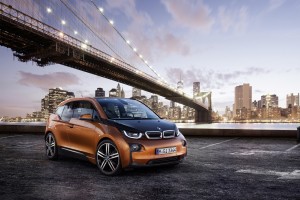
BMW is already considering increasing production levels on its new i3. Global electric vehicles sales are up significantly this year.
Despite the concerns including range anxiety and battery fires, sales of both plug in hybrids and battery electric vehicles have increased significantly.
The Union of Concerned Scientists, a major promoter of electric vehicles, said sales of plug-in electric vehicles (EVs), including both plug-in hybrids and battery electrics, are up significantly compared with last year. More than 59,000 EVs were sold in the United States by the end of August — already surpassing EV sales for all of 2012.
In addition, sales in California, where major manufacturers such as General Motors, Chrysler, Daimler AG and Honda, have focused their attention sales are more than double the rate of last year, representing 29% of U.S. plug-in vehicles sales. California is the one state with tough regulations that require carmakers to offer zero-emission EV’s as part of their fleet.
Overall, Americans have purchased almost 140,000 plug-in vehicles, the organization’s term for both battery electric and plug-in hybrids, which come packaged with alternative power trains, during the last three years, reducing fuel consumption by about 40 million gallons of gasoline.
However, Tesla, the Palo-Alto-based maker of electric vehicles, now faces and a federal investigation into a battery fire that earlier destroyed one of its new Model S sedan. The fire and subsequent investigation of Tesla by the National Highway Traffic Safety Administration, which was apparently delayed by the government shutdown, has sharply reduced the value of Tesla’s high-flying stock.
Meanwhile, top executives from Volkswagen AG said this week they expect carmakers to meet the German government’s goal of putting 1 million electric cars on the country’s roads by 2020 if battery-powered cars like hybrids are included in the mix.
“We will make our contribution toward this goal,” Volkswagen CEO Martin Winterkorn.
Winterkorn said plug-in hybrids, which can switch from battery power and to conventional combustion engines, “offer the biggest market potential,” and should help with a rollout of electric mobility on a larger scale, according to wire service reports from Germany.
(Volvo turns batteries into body panels. To read more, Click Here.)
Volkswagen’s plan to offer as many as 40 electric or hybrid models in the event that demand for low-emission cars takes off. The manufacturer will produce 14 vehicles with alternative drive through next year after introducing electric versions of the Golf hatchback and Up!, which went on sale this month.
Volkswagen also showed new plug-in hybrid versions of the Porsche Panamera and Audi’s A3 compact during the Frankfurt Motor Show. BMW also is moving forward with the introduction of new electric models, starting with the debut of the new i3 this fall.
(Click Here to read about BMW’s new battery car: the i3.)
Purely or partly battery-powered vehicles accounted for 4,157 new car registrations in Germany in 2012, about twice as many as the year before, according to VDA, a German auto-industry association. Germany’s new car market, the largest in Western Europe, amounts to about 3 million vehicles annually.

All of the EV sales combined don’t currently amount to anything but over time they will help auto makers reduce their CAFE fines because the U.S. is the only country in the world with an outlandish 54.5 mpg requirement – which for the majority of cars in the world is simply technologically impossible. That however doesn’t stop the Obama administration and EPA from destroying the U.S. economy in their quest to be seen as “green” or stupid.
Jorge, the CO2 requirements of Europe (with rules in Japan and coming in China) are actually in-effect mileage regs. And they make our 2025 standard seem downright generous. That said, Europeans are used to smaller vehicles. But we are NOT alone. Meanwhile, I recall similar fears and predictions of imminent destruction for every major jump in CAFE since the rules were first enacted in the 1970s. Do I think we can/will make the 54.5 target? Another matter. FYI, with all the credits and such makers receive, the actual mileage average will be more in the mid-high 40 mpg range than 54.5.
Paul E.